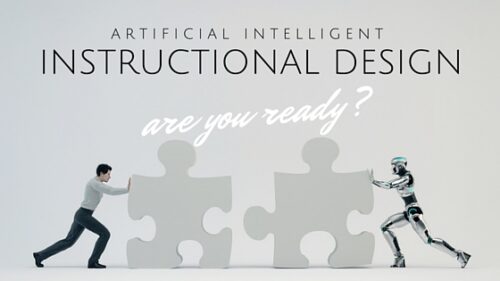Artificial Intelligent Instructional Design
The Artificial Intelligence trend will take the L&D industry by storm. Or by surprise, depending on how open you are to believe it. AI is not something any industry enjoys discussing because it usually means “machines doing the work that humans used to do.” We’re all excited about technologies that help us do our jobs better, but not so thrilled about tech doing our jobs for us. Writers were transitioned from print to blogs. Musicians were transitioned from CDs to internet singles, and YouTube. The job of instructional design will transition as well, but into what is not clear. But the reality is that computers can and will do it better than we do.
What is AI Currently Capable of Doing?
AI conversations often revolve around the creation of robots that help us complete tasks, and, at least partially, think for themselves. But AI is much more useful than that even with today’s tech. It’s not just a dream for the future. It’s part of the reality of today. Not only did technology disrupt publishing, but in at least 2 use cases technology has already illuminated human writers. Simple sports and news reports are now generated completely by computer. Writing instructional content is a logical business application and saving companies money.
“Look!” he says, “we are humanising the machine and giving it the ability not only to look at data but, based on general ideas of what is important and a close understanding of who the audience is, we are giving it the tools to know how to tell us stories.”
We currently only consider the possibility of personalized instruction. And in those conversations we discuss a computer deciding what content should be presented and in what order. I don’t think anyone in our industry is considering computers actually creating learning content as well. And yet all technology signposts point in that direction.
Artificial Intelligence, Web Publishing and eLearning
In a recent entrepreneur magazine article AI is discussed as part of a web site building system.
“Founder and CEO Dan Tocchini IV says his goal is to enable business owners to wrest control from web designers and template-driven website services. “You’re not sending ideas back and forth with a designer, waiting weeks to approve the latest backend,” Tocchini says. “All that latency is gone.””
Exchange the term “web services” with instructional design services, and “template-driven website services” with template-driven training course design and you have the future of the learning management system. The name will probably never catch on, but in our industry the feature might be called Artificial Intelligent Instruction Design… or AIID.
There are many simple rules that instructional designers follow when designing content. They’ve been well documented in books like Ruth Clark’s E-Learning and the Science of Instruction. One of the most widely quoted in elearning development groups is the theory of cognitive load. A quick google search turns up this quote…
“In cognitive psychology, cognitive load refers to the total amount of mental effort being used in the working memory. Cognitive load theory was developed out of the study of problem solving by John Sweller in the late 1980s. Sweller argued that instructional design can be used to reduce cognitive load in learners.”
Considering what a little artificial intelligence can currently do for web design in systems like the Grid, integrating elements that support cognitive load theory is not that far off. In fact, it would not surprise me if The Grid’s AI didnt already define it’s solutions based on the science of designing content for human consumption. Since much of eLearning development has focused on content design issues, I would guess that AI can handle that for the eLearning industry as well.
Even our learning solutions design processes are based on simple decision tree structures. Any check list currently in use for audience analysis, and conclusions you draw from them, will soon be part of a Learning Solution Designer system’s AI. The LSD could even use HR records to constantly perform employee/learner analysis and define learning solution algorithms based on that data. I would expect that my friends promoting xAPI have considered this future and firmly planned a stake in the ground of xAPI being part of that future.
LMS’s like other internet sites already use a form of AI in the form of responsive design. You, the trainer, simply upload a video to the LMS and the system decides how to deliver that video based on the device being used to view it. Your work as instructional designers is already significantly easier than it was 10 years ago. AI will soon take even more human work out of the process. This is just another reason why non-training professionals are quietly leading the revolution in L&D within corporations.
Why Business Will Love AIID and LSD
The move to eLearning by corporations was largely a decision made by the bean counters. When looking at the human resource costs, travel costs, and material costs, it was easy to see how much money could be saved moving all that online. Consider how much more money will be saved when all employees have the ability to load content into a system and have that system analyze the content and then reconfigure it to match instructional design theories like cognitive load. Not only that, its ability to assess HR data to create and present the instruction in a format best suited for each individual. And that doesn’t just mean adjusting the CSS depending on the device. No. It means writing unique content for each individual based on skill level, past experience, and personal data…and THEN presenting it with contextually appropriate imagery and multimedia content in the proper format for each device.
What will this look like? I can imagine one scenario in which a training session between a SME and a new hire is recorded and converted to training material instantly by the LSD. A webinar tool like gototraining might be used to manage the live conversation and record it. when the session is over the video is analyzed and a series of options are presented to the SME. For example a voice like siri might say “I noticed your vocabulary is at a the level of Engineer-PhD. Would you like me to publish a version more suitable for the greater employee population?” Or something like that.
The possibilities are limitless. But this scenario won’t happen over night. It will be an evolutionary process that has already started. Some of my first CBTs took months to create with large teams supporting the design, development, and delivery. We had to code multiple choice questions manually where today its as easy as importing a spreadsheet of questions into the LMS. Tomorrow’s LSD will review the video of a training event and create assesments automatically based on a multitude of corporate, business, amd personel data. It’s a future not quite fully baked, but the ingredients are ready for mixing. Are you ready?






